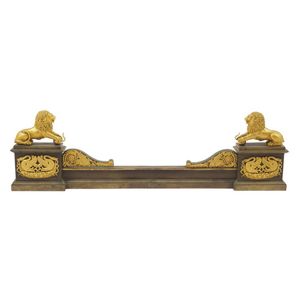French Empire Ormolu Bronze Fire Fender with Crouching Lions
You must be a subscriber, and be logged in to view price and dealer details.
Subscribe Now to view actual auction price for this item
When you subscribe, you have the option of setting the currency in which to display prices to $Au, $US, $NZ or Stg.
- Bronze - An alloy of copper and tin, traditionally in the proportions of about 9 parts of copper to 1 part of tin.
The discovery of bronze in Western Asia in the 4th century enabled people to create metal objects which were superior to those previoulsy possible because of its strength and hardness, and it has been used throughout the world for weapons, coins, tools, statuary and other decorative items.
It is very fluid in a molten state, and its hardness, strength when set, and non-corrosive properties makes it most suitable for casting sculpture. - Ormolu - Ormolu was popular with French craftsmen in the 18th and 19th century for ornamental fittings for furniture, clocks and other decorative items. True ormolu is gilt bronze, that is bronze that has been coated with gold using a mercury amalgam. Due to the health risks associated with using mercury, this method of creating ormolu was discontinued in France in the 1830s. A substitute was developed consisting of about 75% copper and 25% zinc, however it was inferior to the bronze version. It was often lacquered to prevent it tarnishing.
- Circa - A Latin term meaning 'about', often used in the antique trade to give an approximate date for the piece, usually considered to be five years on either side of the circa year. Thus, circa 1900 means the piece was made about 1900, probably between 1895 and 1905. The expression is sometimes abbreviated to c.1900.
- Gilding - Gilding is a method of ornamentation whereby a thin sheet of gold metal is applied to items made of wood, leather, ceramics, glass and silver for decorative purposes.
For furniture including mirrors, the sheet of gold is usually applied over a coating of gesso. Gesso is a mixture of plaster of Paris and gypsum mixed with water and then applied to the carved wooden frames of mirrors and picture frames as a base for applying the gold leaf. After numerous coats of gesso have been applied, allowed to dry and then sanded a coat of "bole", a usually red coloured mixture of clay and glue is brushed on and allowed to dry, after which the gold leaf is applied. Over time parts of the gilding will rub off so the base colour can be seen. In water gilding, this was generally a blue colour, while in oil gilding, the under layer was often yellow. In Victorian times, gilders frequently used red as a pigment beneath the gold leaf.
Metal was often gilded by a process known as fire gilding. Gold mixed with mercury was applied and heated, causing the mercury to evaporate, the long-term effect of which was to kill or disable the craftsman or woman from mercury poisoning. The pursuit of beauty has claimed many victims, not the least of which were the artists who made those pieces so highly sought after today. - Heraldic Decoration - Heraldic decoration on silver, glass, and porcelain refers to the use of coats of arms and other heraldic symbols as decorative motifs on these materials. Coats of arms were traditionally used to identify individuals, families, and institutions, and were often displayed on shields, banners, and other objects.
The heraldic decoration typically takes the form of engraved or etched designs that incorporate coats of arms or other heraldic symbols. Heraldic decoration on silver, glass, and porcelain has a long history, dating back to the medieval period when coats of arms were first used. During the Renaissance and Baroque periods, heraldic decoration on decorative objects became increasingly elaborate and ornate, with finely detailed designs that often incorporated intricate scrollwork, mythological figures, and other decorative motifs.
In the 18th and 19th centuries, heraldic decoration became particularly popular among the aristocracy and upper classes, who used these objects as symbols of their wealth and status.
This item has been included into following indexes:
Visually similar items

A fine Restauration ormolu clock, circa 1815-1830, an elegant silk suspension clock with an engine turned dial with Arabic numerals set within a plinth and surmounted by the figure of Orpheus playing his lyre, a soothed lion at his side, bas relief allegor

Fine antique French bronze mounted brass fire andirons and bar (2)

A 19th century French gilt metal sculptural mantel clock, modelled with an Elizabethan figure, the circular dial with Roman numerals, the pendulum movement striking on a bell. With key. Scroll missing from hand. Height 33 cm

A gilt bronze figurative mantel clock featuring a Roman chariot scene, key present and correct, 51 cm long
